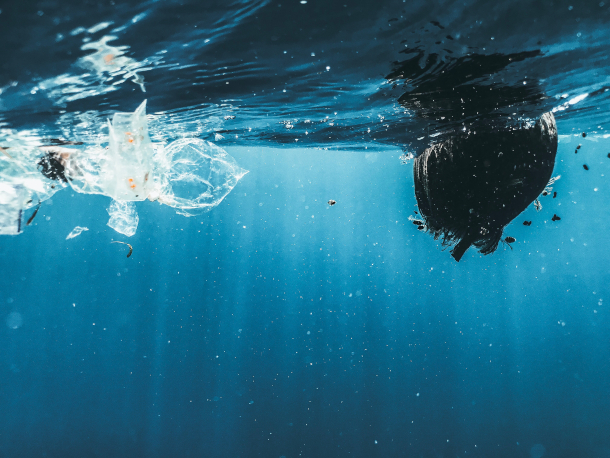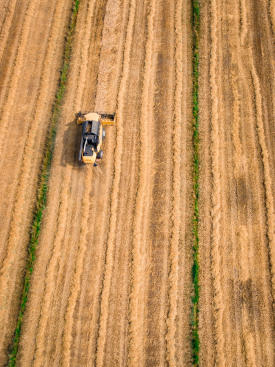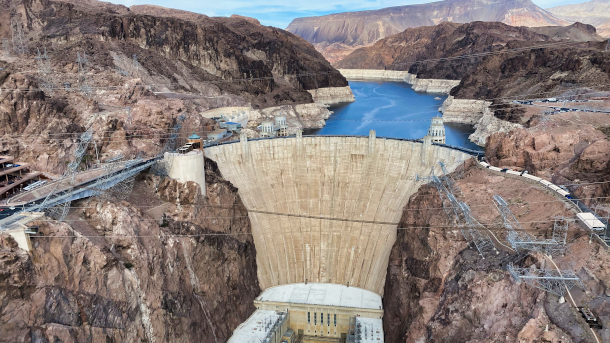Beyond the Headlines
Air Date: Week of July 1, 2022

Researchers at Sichuan University have developed a fishbot that could help clean up microplastics in the ocean. (Photo: Naja Bertold Jensen on Unsplash)
Environmental Health News Editor Peter Dykstra joins Host Steve Curwood to discuss the statistic that less than 50% of our world’s annual grain production is eaten by humans. They then review the innovative microplastic-removing “fishbots” coming out of a research group at Sichuan University and finish up with an anniversary for the Hoover Dam, a massive source of water and hydropower approved for development 93 years ago.
Transcript
CURWOOD: Well, it's that time in the broadcast when we turn to Peter Dykstra. For a look Beyond the Headlines, Peter is an editor with Environmental Health News. That's ehn.org and dailyclimate.org. He's on the line now from Atlanta, Georgia. Hey, Peter, it's been pretty hot here. What about down south with you?
DYKSTRA: Last week, we hit 100º a couple of times; this week, it's a little bit lower than that. But it's still summertime hot in Georgia.
CURWOOD: Ouch.
DYKSTRA: Well, Steve, let me tell you a couple of things that I found interesting this week. According to the World Food Program, most of the world's grain is not eaten by humans. We produce just under 3 billion metric tons of grain a year. And more than half of that goes to feed animals or is used as biofuels like ethanol.
CURWOOD: So even in this time of grain shortage, because we've got this war going on with Russia's invasion of Ukraine, and of course, the recurrent hunger problems, we're not eating half of what we produce, and it's going to animals?
DYKSTRA: Yeah, we're talking about all of the common staple grains: corn, wheat, millet, rye, oats. And the world is desperate to feed itself. Ukraine and Russia have more than complicated the situation. But all of that grain that goes to feed animals, in turn, those animals are used to feed us, which creates health problems, climate problems, and more.

According to the World Food Program, humans eat less than 50% of the grain we produce. The majority of grain goes to animal feed and biofuel. (Photo: Kees Streefkerk on Unsplash)
CURWOOD: Peter, since most of the grain isn't eaten directly by humans, but goes to livestock, if we cut down on our eating of meat as a species, we will not only help the climate - because there's a lot of climate related gas emissions associated with all that meat - we also help lessen the shortage for other people on the planet who need to eat.
DYKSTRA: That's right. And if I can say this in the politest way possible, we could use a little bit less meat eating here, where of course other parts of the world don't get enough food and don't get enough nutrition.
CURWOOD: So, there's plenty of grain to go around for people to eat directly as long as we make the right choices. Heya, what else do you have for us today?
DYKSTRA: The word for today is: fishbots. There was a study published last week in the journal Nano Letters. Researchers in China at Sichuan University created a fishbot made out of composite material that can draw microplastics to itself as it swims. The Sichuan University team thinks that the new bot could be used to transport microplastics to another location where they can be collected and properly disposed of.
CURWOOD: Hey, Peter, just give me a little tech lesson. How exactly does this fish bot attract microplastics to it?
DYKSTRA: These fishbots react to a near-infrared light laser. Blinking the laser on and off causes the fishbot tail to flap back and forth acting like a fish. And as it moves along, plastic material sticks to the body of the fishbot.
CURWOOD: This would be an amazing solution to a huge problem. I mean, we're literally choking the oceans with microplastics. But it sounds like this isn't exactly an inexpensive device.
DYKSTRA: Not necessarily inexpensive, not necessarily efficient, and certainly not necessarily something that's going to rid the world of the microplastics problem. But it's an innovation. And if we have 1000 innovations, we might be able to put a dent in the huge problem of plastic pollution.

On June 25th, 1929, President Herbert Hoover authorized construction of the Hoover Dam (originally Boulder Dam). Today, overuse and drought threaten the American Southwest’s water supply. (Photo: Ryan Thorpe on Unsplash)
CURWOOD: Okay, well, I like that, a sign of hope to deal with the plastic problem. Hey, what do you have from the annals of history for us today?
DYKSTRA: On June 25th, 1929, President Herbert Hoover authorized the construction of a huge dam at the Boulder Canyon near the very small town of Las Vegas, Nevada. The Boulder Dam was eventually renamed the Hoover Dam, and it supplies water and electricity to farms and homes in Nevada, Southern California, and Arizona.
CURWOOD: There doesn't seem to be a whole lot of water in the Colorado River system now to keep operating the Hoover Dam the way it once operated.
DYKSTRA: The Colorado River and the Southwestern US is in crisis over water. LA, San Diego, Orange County, Las Vegas, Phoenix. And even before you get to watering the populations in the cities or providing hydropower for them, about 70% of what comes down to the Hoover Dam is used for agriculture. So, the Hoover Dam is going to have to work overtime. And they're going to have to find more new ways to conserve water and to find water to keep the American Southwest powered and watered.
CURWOOD: I think you're right, Peter. I mean, we're facing a real crunch there, thanks to the climate and thanks to the development that we've brought to the desert southwest. Thanks, Peter for all these stories. Peter is an editor with Environmental Health News, that's ehn.org and dailyclimate.org, we'll talk to you again real soon.
DYKSTRA: Okay Steve, thanks a lot, talk to you soon.
CURWOOD: And there's more on these stories on the Living on Earth webpage, that's loe.org.
Links
The Economist | “Most of The World’s Grain Is Not Eaten by Humans”
The Daily Beast | “Can a Future Fleet of Robotic Fish Clean Up the Ocean?”
Living on Earth wants to hear from you!
Living on Earth
62 Calef Highway, Suite 212
Lee, NH 03861
Telephone: 617-287-4121
E-mail: comments@loe.org
Newsletter [Click here]
Donate to Living on Earth!
Living on Earth is an independent media program and relies entirely on contributions from listeners and institutions supporting public service. Please donate now to preserve an independent environmental voice.
NewsletterLiving on Earth offers a weekly delivery of the show's rundown to your mailbox. Sign up for our newsletter today!
 Sailors For The Sea: Be the change you want to sea.
Sailors For The Sea: Be the change you want to sea.
 The Grantham Foundation for the Protection of the Environment: Committed to protecting and improving the health of the global environment.
The Grantham Foundation for the Protection of the Environment: Committed to protecting and improving the health of the global environment.
 Contribute to Living on Earth and receive, as our gift to you, an archival print of one of Mark Seth Lender's extraordinary wildlife photographs. Follow the link to see Mark's current collection of photographs.
Contribute to Living on Earth and receive, as our gift to you, an archival print of one of Mark Seth Lender's extraordinary wildlife photographs. Follow the link to see Mark's current collection of photographs.
 Buy a signed copy of Mark Seth Lender's book Smeagull the Seagull & support Living on Earth
Buy a signed copy of Mark Seth Lender's book Smeagull the Seagull & support Living on Earth

